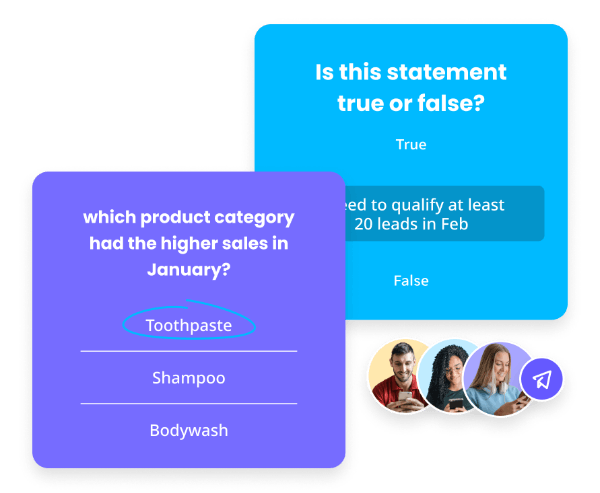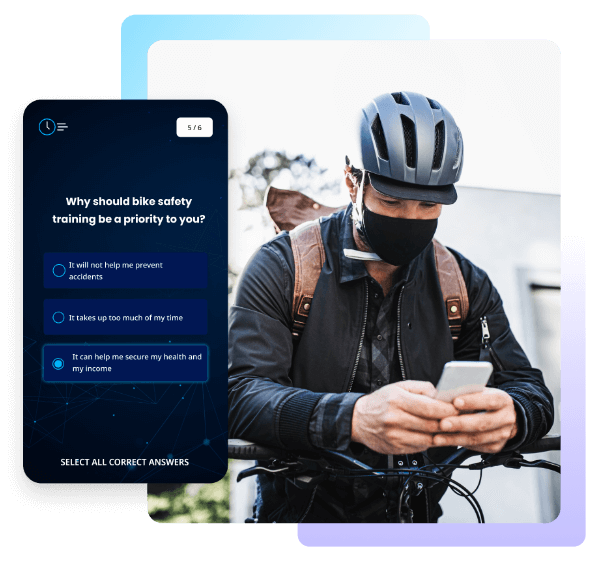Why workplace training matters: Definition, importance, types

Investing in your team is investing in your organization’s growth. As the backbone of your business, employees should be equipped with high-quality and relevant workplace training to help gear them up for success.
Fuel them with innovative ideas, elevate the skills they bring to the table and renew their passion for work by prioritizing training. Whether you’re onboarding a new hire or expanding a senior employee’s responsibilities, training plays a crucial role in keeping your team on track.
Here, we’ll help you unlock your organization’s full potential by diving into the whats, whys, and hows of workplace training.
What is workplace training?
Workplace training is an essential tool used in developing your team’s skills and knowledge. It helps organizations achieve their goals by making sure that the growth of every team member matches up with what your business needs.
Help your team keep up with the latest trends, adapt to new technologies, and tackle challenges head-on. Design training programs that are tailored to their individual needs and the team’s goals, so you’re assured of a smoothly running workplace that positively contributes to your organization’s success.
Why is training important in the workplace?
Looking to double your profits? Data from the Association for Talent Development shows that organizations that invest in comprehensive training programs lead to a 218% increase in revenue per employee.

It’s high time we view company training as an opportunity for growth not just for employees, but for the business itself. While a lot of workplace or staff training requires you to shell out money at the onset, the returns on investing in proper and ongoing training outweigh that initial expense.
Still need more convincing? We’ve listed other benefits of workplace training for both you and your teams.
- Bridging skill gaps and expanding areas of expertise: Open doors for growth by developing your team’s areas of improvement. You can also fill voids left by former employees by expanding your team members’ knowledge and skill sets.
- Maximizing productivity and boosting performance: Make sure your teams put their best foot forward. Workplaces that put a prime on training are equipped with more capable, confident, and motivated employees.
- Better job satisfaction: Workplace learning is one of the best employee engagement strategies. When you foster a culture of growth, employees find more fulfillment in the work they do.
- Meeting workplace standards: Whether you’re trying to maintain internal standards or following mandatory compliance policies, training helps you stay on track with these goals.
- Promoting team members and creating new roles: Planning to introduce new roles? Have employees that are ready to take on bigger responsibilities? Prepare your teams for what lies ahead through proper orientation and onboarding training sessions.
- Improving company reputation and customer satisfaction: Ongoing workplace learning helps minimize risks by teaching employees how to avoid mistakes. It also attracts new and competent talents who want to expand their horizons.
Different types of training
A well-designed training is one that suits your team’s specific needs. Because these needs vary from organization to organization, there is no “one size fits all” approach to training that works for every business out there. That’s why we’ve listed the different types of training so you can choose what works best for your team’s goals.
Onboarding training
If you have new hires joining the team, they’re often welcomed with this first type of training that introduces them to the organization’s values and goals. Onboarding programs typically include departmental training that briefs them about the knowledge needed for their day-to-day responsibilities.

Hard skills development training
Also known as technical skills training, this type of training focuses on industry-specific skill sets that are at the core of an employee’s responsibilities. Some examples include coding, technical writing, data analysis, and construction training.

Hard skills training is directed to particular roles. If you’re a retail business wanting to conduct social media and electronic communication training to engage your customers, this best applies to your sales and advertising team. But it won’t be as relevant to your warehouse clerks or cashiers.
Soft skills development training
Soft skills training is aimed at developing team values and individual traits that promote a better connection with colleagues and customers. It's just as important as hard skills training as it teaches teams about crucial topics that build stronger team dynamics and smoother work operations.

Some possible topics in soft skills training include communication, time management, conflict resolution, and leadership.
Safety training
Safety training is important in every workplace, especially in ones that deal with physical labor and hazardous materials. This type of training equips employees with knowledge on how to deal with work-related injuries, as well as action plans for disasters through drills and evacuation plans.

In countries like the US, safety training is made mandatory across various industries through the Occupational Safety and Health Administration (OSHA). Whether you’re a starter in a new industry or a senior worker looking for refresher programs, OSHA training online courses are easily accessible to help you in your safety training.
Team training
Conducting team training is a sure-fire way to build more cohesive teams. What sets team training apart is that it is completed as a group instead of individually. A team that runs smoothly is a team that collectively works more efficiently.

Group training often tackles collaboration, communication, and building good working relationships. Apart from these skills, team training is effective when every individual member is left with a sense of belongingness after the session.
How to improve training and development in the workplace
Now that we’ve tackled the importance of training and development in the workplace, it’s time to put that knowledge into action by listing down the best practices for effective training.
1. Make workplace training fun
Contrary to popular belief, training doesn’t have to be boring. Add some spice to training through gamification. The Gamification at Work survey revealed that 89% of employees believe that gamification elements at work make them feel more productive.
If you need a headstart at gamifying training, top e-learning management platforms like SC Training offer over 80 gamified templates that you can use to transform how your teams train. Make training more engaging through game-based quizzes, badges, and real rewards.

2. Create employee training goals
Pave a clear path for your teams by setting objectives. With a clear end in mind, you and your teams know what you’re working toward. Setting training goals helps you create a structured roadmap, provides a measurable benchmark to track progress, and acts as a motivation for teams to take action.
Flexibility is an important part of goal setting. It’s vital to set clear and specific goals from the get-go. But it’s also necessary to leave room for change as unexpected obstacles arise.
Learn to adapt and modify your approach without fully abandoning your goals through SC Training’s in-built analytics. This free learning platform allows you to identify knowledge gaps and track employee progress through its admin portal, helping you use a data-backed approach to adjusting your objectives as you go.

3. Gather feedback
One more key tool in identifying when and how to adjust your training goals is getting feedback from your employees. This is a critical step in making sure that training is effective, and in implementing changes if it turns out that your current methods aren’t working for your teams.

Use employee surveys, forums, and feedback forms to collect your team’s insights. SC Training’s discussions feature is a good employee management tool that allows you to gather real-time feedback and facilitate an open discussion so your teams can also turn to their peers for a more interactive environment.
4. Consider training costs
Make sure you and your teams get the most out of what you invest in training. Better yet, maximize learning platforms that allow you to train for free! While training is an investment, it doesn’t necessarily have to be expensive.

There are learning management systems that allow you to do just that. For example, SC Training offers employee training programs that are completely free and readily available online.
5. Make training accessible
We know your team’s a busy bunch. Save precious time by taking advantage of training that you can access anytime, anywhere. Accessibility calls for training that your teams can easily do even when they’re out of the office and at their own pace.
One of the best ways to do this is through leveraging mobile training platforms. SC Training allows you to easily deliver training since it's built with mobile in mind. And while most digital learning platforms require an online connection, SC Training is accessible even when you’re not connected to the internet.

Accessibility also entails that training is easily digestible. Use SC Training’s microlearning feature to break down complex topics into bite-sized lessons so your teams can easily retain the knowledge they need.
Kickstart your workplace training journey with SC Training today. Sign up for free.
Author
Bea Garcia
Bea Garcia is a content writer for EdApp, a cutting-edge e-learning platform designed to democratize training. Beyond her writing desk, she spends her time trying out recipes and watching films.
